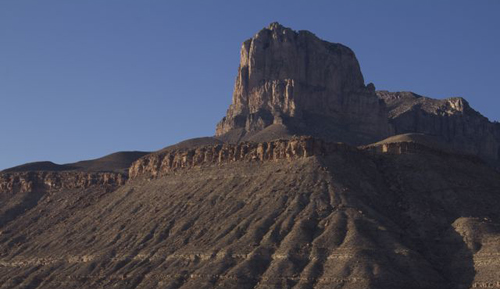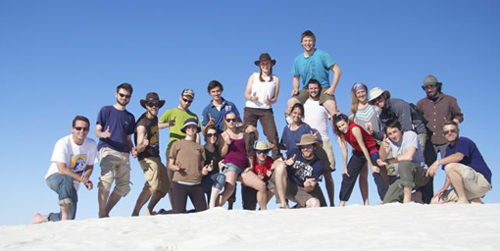Capitan Reef/Delaware Basin 2012
As part of EPSC 425 (Sediments to Sequences) and a coupled graduate course on sedimentary basins, 14 undergraduate students, 5 graduate students, and T.H. Clark Chair Galen Halverson traveled to West Texas and southeast New Mexico in late February to visit the world famous late Permian Capitan Reef complex of the Delaware Basin. This Shell Canada-sponsored field trip was the first of what we hope will be regular winter mid-semester break sedimentology excursions for advanced undergraduate and graduate students in EPS. In preparation for the trip, the undergraduates presented topical reviews on the Deleware Basin and compiled a volume of summary papers, which can be downloaded here.
 Late afternoon view of El Capitan from highway 62/180, just outside Guadalupe Mountains National Park.
Late afternoon view of El Capitan from highway 62/180, just outside Guadalupe Mountains National Park.
The trip began with an early Saturday morning flight to DFW, and onward connection to El Paso, Texas. Our flight arrived late, so by the time we were packed into our rental vans and stocked up on food an other supplies, the day was nearly over. Neverthless, we made it to our group camp site at Pine Springs Campground on the southeastern side of Guadalupe National Park. We spent our first two days at the park on the famed McIntrick Canyon Permian Reef Trail, where, following in the footsteps of many spring break geology groups before us, we traversed the transition from the toe-of-slope to the shelf crest. Cephalopod fossils, fusillinid coquinas, debris flow breccias, and bioturbated lime muds were just some of the many highlights of the trail. By the end of the seccond day, the students had completed an unparalled introduction to carbonate sedimentology and Permian paleontology.
 Lunch on the McIntrick Canyon Permian Reef trail.
Lunch on the McIntrick Canyon Permian Reef trail.
On day 3, students split into two groups to take in the expanse of the Capitan Reef complex. The larger group tackled Guadalupe Peak, which at 2667 m, is the highest point in Texas. The smaller group traversed from camp, into the basinal deposits with turbidite sand lobes and organic-rich source beds, and up to the base of El Capitan. The next two days were spent exploring the reef crest and back reef environments around Whites City and Carlsbad, NM. Carlsbad Caverns, was of course, a highlight. Occasional acrobatic tumbles into prickly pear cactuses provided additional diversion. But it was the last stop in the Deleware Basin, where we we saw a bitumen-impregnated vuggy lagoonal dolostone, that was perhaps the most instructive, as it made clear why so many geologists had come to study these rocks before us—and why there are so many oil wells around Carlsbad!
We concluded our fantastic week in West Texas and New Mexico by climbing the picturesque Sacramento Mountains, then descending rapidly into the Alamagordo plain. Before returning to El Paso, we stopped at White Sands National Monument, where students, TAs, and the instructor walked and frolicked in the gypsum sands for an afternoon. I am sure that between jumps and slides down the lee sides of the dunes, all of the students took careful note of the fossilized cross-bedding in the interdunes, which looked as much like the tread marks of an offroad vehicle. Later that evening, after much needed showers and changes of clothes, we celebrated a succesful field trip with a large dinner of enchiladas, tacos al pastor, and other mexican fare that is difficult to find in Montreal.
